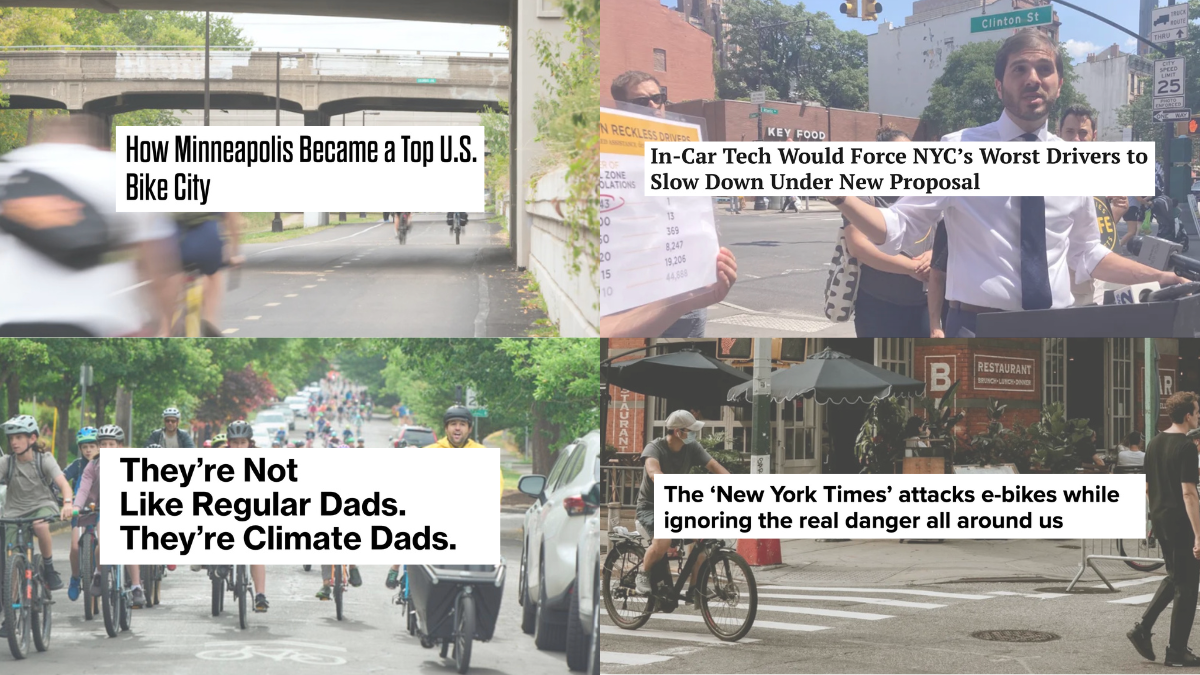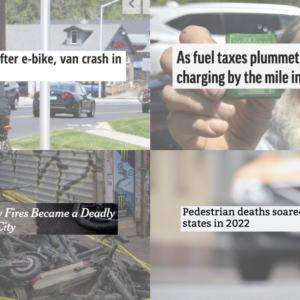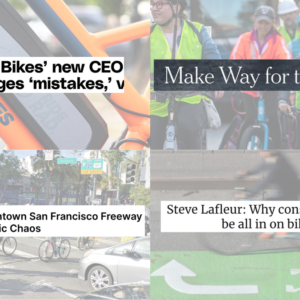Welcome to the week. Here are the most notable stories our writers and readers have come across in the past seven days…
More than just fun on bikes: I believe wholeheartedly with this essay by Hillary Clinton that social isolation and loneliness are a ticking time bomb in America and it’s why I am such a supporter of things like Pedalpalooza, open streets events, Bike Happy Hour, and so on. (The Atlantic)
Minneapolis as a model bike city: Portland planners and advocates should pay more attention to how Minneapolis became America’s #1 ranked cycling city and it should be our goal to unseat them. (People for Bikes)
Climate dads: “Like sports dads, grill dads and car dads before them, climate dads are a little bit nerdy, a little bit obsessive and, sometimes, a little bit embarrassing.” Another great piece of publicity for Portland’s bike bus too! (Bloomberg)
Time to get tough on drivers: “We are going to literally force you to slow down by requiring you to install a speed limiter on your car.” This is the type of toughness I’d love to hear out of Portland politicians’ mouths. (Streetsblog NYC)
Latest on auto size abuse risks: It’s heartening to see the tide against car bloat rise to such a high level. This is a good article that summarizes the issue and has links to resources on how to do something about it. (The Conversation)
Protest at Worlds: The Road Cycling World Championships race in Glasgow was forced to stop when environmental protestors entered the course and glued themselves to the road to draw attention to team sponsors they say are responsible for pollution. (BBC)
The real danger: I’m glad someone else is pointing out the tendency of media outlets to blame e-bikes and their operators for dangers and not cars and their drivers. (Electrek)
Track the bastards down: A new alert system in the state of Washington aims to find more hit-and-run drivers. (Washington State Patrol)
Overcoming off-road fear: Pro mountain biker Kate Courtney has worked hard to find zen when it comes to tackling jumps and drops at high speeds. (Red Bull)
Traffic camera troubles: Given the growing role automated enforcement cameras will play in Portland, it’s worth tracking how progress is going to install them up in Seattle. (The Urbanist)
Thanks to everyone who shared links this week!







Thanks for reading.
BikePortland has served this community with independent community journalism since 2005. We rely on subscriptions from readers like you to survive. Your financial support is vital in keeping this valuable resource alive and well.
Please subscribe today to strengthen and expand our work.
CityNerd’s take on Minneapolis & St. Paul: https://youtu.be/leZ6vIpwSVA
With the various greenways (Ground Rounds, Midtown, etc.) there was good connectivity between recreational areas before the street bike lanes were added.
The on-street lanes are hit-n-miss for usability. Some are great, near Dutch experience, some are the dreaded plastic pole farms. If you look at the map, there are gaps that require some planning to work around. For instance, getting to the Milwaukee Avenue Historic District from downtown is a wee bit of winding around. But getting to Theo-Wirth from downtown is a breeze. And then there is St. Paul… Another thing to remember is that certain suburbs have great connectivity, like Woodbury, and others do not.
yes I’ve heard that a lot about Minneapolis – that their off-street path network is great but that on-street is bad. I assume that’s getting better. I just want folks to know that I think these PFB cityratings are the best thing out there and Portland leaders should actually care about them.
The thing about their off-street path network is that it’s pretty much notrepeatable for any city in the country. Minneapolis was a major rail hub before the 70s mergers and acquisition era. The Burlington Northern merger in particular really minimized Minneapolis as an import hub – since the interchanges between Northern Pacific and Great Northern with the various midwestern carriers like the Burlington, Chicago & NW, and Milwaukee Road were no longer really needed.
In the US, having a network of off-street path pretty much means that a legacy railroad network was removed in some part after 1970. Portland unfortunately paved over most of the legacy rights of way before the 70s, and didn’t have nearly as much infrastructure to lose to begin with.
And this is part of a larger point. Off-street paths are great, but they are exceedingly difficult to create unless there are some specific historical circumstances. Minneapolis had these circumstances, Portland did not. So what does Portland really have to learn from Minneapolis here? That they shouldn’t have paved over the SP and OE rights of way in the West Hills in the 20s to 40s?
See my link to Woodbury’s kinda-sorta-off street system for a template any city. This video is kina old, but it does show the way the majority of trails in Woodbury work: replace one sidewalk in the right-of-way with a paved trail. Richfield, MN is a good example of this, do a street view of West 66th Street near the Tazzah restaurant. That type of infrastructure doesn’t work so hot in a core downtown, but places like south/east Portland could have that put in ASAP.
Where I think Minneapolis is a good example is that a) the plan they have is ambitious and b) they are implementing it 100% when they redo a street. 5-10 years ago, most of the on-street bike lanes didn’t exist. The whole “it’s not perfectly suited to us, so we need to ignore it” is just a way to dismiss the idea there might things to learn from others.
You nailed it, blumdrew. The old SP ROW in SW Portland was abandoned, so now the city really has no good options for the Red Electric Trail.
If Portland and other cities really want to get serious about bike infrastructure, they are going to need to take roads *away* from cars and dedicate them to bikes and peds only. But no politician wants to be the one to face the inevitable backlash that will swiftly come. I don’t see the situation ever changing, barring some real crisis.
While Minneapolis’ flagship off-street facility, the Midtown Greenway, is on former rail right-of-way, the vast majority of its path system is not. Rather, most paths in Minneapolis are on park land, and while most of that and was acquired more than 100 years ago, and some paths were built at the time, the current path system basically dates to the 1970s.
So any city with large amounts of parkland has something to learn from Minneapolis: 1. Plan a routes that connects your parks 2. Build modern paths (I.e separate facilities for bikes & pedestrians & actually wide enough to accommodate users) in your parks 3. Build protected bikeways connecting the parks
Pretty sure Portland likes to brag about its parks. Based on the Trail Design Guidelines, it seems that they actively resist connecting them though (“if a city bikeway is allowed to connect to existing park paths…” p. 35) and they have no interest in actually accommodating users (there is no mention of separating bike/ped uses & their minimum width is just 8’ unless they also want to destroy the path by letting their maintenance trucks use it for shortcuts).
So no, it’s not technically difficult to build off-street paths, as most cities own huge amounts of land. The difficult part is convincing city officials to build the paths.
The on-street network isn’t all bad in Minneapolis. The Minneapolis core is actually very good, if basically 4 streets right now. As you get outside the core and head in one the cardinal directions, it can get pretty goofy in spots, especially along high auto traffic arterial roads. In the residential neighborhoods, it gets good again, until you have to hit an arterial road.
I love the twin cities, but yeah the on street network isn’t that great even compared to Portland’s somewhat disjointed network. And seeing as we aren’t in the position to create an offstreet path system, I struggle to see how much there is to learn from the twin cities.
I’m not going to defend Minneapolis’ on-street network as much as I’ll defend its off-street network (the best in the country imo). But I’m really surprised to hear Portland’s network favorably compared to it. Portland has basically one decent on-street bikeway with separation, right? Vancouver/Williams? And now it has Naito, too, but that’s no more than a mile long. Minneapolis, meanwhile, has several separated on-street facilities of multiple miles, Blaisdell/1st Aves, Washington Ave, Plymouth Ave, and 26th/28th are a few that come to mind that are protected by curbs in at least a few places. There is a grid of separated facilities in most of the city, with the only blank or patchy spots in far southwest and northeast. In Portland, there is a huge swath of the city that is rich in destinations and has almost no separated bike facilities at all, from like 12th to 60th and like Killingsworth to Powell. Or is there a secret Portland bike tunnel that I never got the password to?
Portland of course has a large non-separated network of varying quality, and, perhaps related, a much more respectful driving culture than Minneapolis. But honestly, I make a wrong turn almost every time I ride a bike in Portland because the neighborhood greenways zig and zag so much that I end up on a non-calmed street anyway.
If all you’re going off of is what you’ve heard from others, know that Minneapolis’ on-street network has made huge strides in the last 20 years. Every time I go back there is a new protected lane it seems, like in June I used the new two-way bollard protected lane on Dunwoody to connect to curb separated lanes on Hennepin & Washington downtown from the Cedar Lake trail. I guess it’s a bit like taking the Springwater to the Tilikum Crossing to the South Waterfront Path (?) to Naito except you only turn twice instead of 3,239,638 times.
Unfortunately Minneapolis’ progress was built on a progressive majority in the city council that has been replaced by a more centrist group, and anyway the council’s power has been reduced in favor of the mayor, who appointed a deeply political public works director who is stepping back from the high quality plans of the last decade. See for example the Bryant Ave bikeway, which basically replaced half the roadway with an off-street path in the first phase but has been reduced to a more typical curb-separated two-way facility for the second phase. Still, would even the downgraded plan even be considered in Portland? I guarantee it wouldn’t be considered in Eugene, and from what I’ve read on this site Portland politicians would speed away in their Teslas from such a plan.
Meanwhile in the EU speed limiters have been mandatory on all new motorvehicles for over a year. Just another example of how “not just bikes” is dead on when it comes to north america.
I think you need to read this article and see how the the technology actual works
https://jalopnik.com/no-europe-didnt-just-force-automakers-to-install-spee-1849191252
First if your stupid enough to speed through a speed camera more than one time, you deserve more fines and restrictions. My question is why the fine is only $50.00. Why not try increasing the fine to say $200.00. Also use a sliding scale that increases the fine for repeat offenders. Personally, I would use an exponential scale rather than a linear scale.
Adding speed limiting to future cars is easy. Adding to existing cars gets complicated. It would depend on if the throttle is controlled by the ECU or the old-fashioned way. A cable between the accelerator and the throttle body (or carburetor). The other issue is determining what the actual speed limit is. The database that GPS units (and Google Maps) use is not complete. All my GPS units display the speed limit if its in the database. But several streets (even in Portland) show no speed limit on my GPS. Another problem is when the limit is changed. It can take several months before the map updates to the new limit. A secondary system using a camera to decode speed limit signs could be added.
Kevin Krizek is a professor of urban planning and street design, so It’s no surprise that his article focuses on infrastructure changes rather than individuals’ driving behavior. I think that’s just common sense, but it’s helpful to see various case studies on the safety benefits of designing streets for people rather than cars.
I’m also glad to see the link spelled out in a mainstream publication between vehicle size and weight and the CAFE “light truck” loophole. To me this is a way more convincing explanation for the growth of SUVs and pickups than the idea that half of all Americans became off-road enthusiasts virtually overnight.
Whoops, I meant four-fifths of Americans:
“In 2022, sales of light trucks accounted for about 79.2 percent of the approximately 13.75 million light vehicles sold in the United States.”
https://www.statista.com/statistics/199980/us-truck-sales-since-1951/
“The Real Danger” (cars or ebikes?) — this is not an “Exclusive Or” situation. Both can be real dangers.
I’m somewhat skeptical of PFB. I think it’s a fine enough tool, but certainly not the end all be all of how useful or practical it is to ride a bike in a city. Am I really supposed to believe that Chicago is a worse city for biking than Tulsa? Or that Minneapolis was a middling city for biking before they changed residential speed limits to 20 mph? Like sure, that’s good. But does it make the city twice as good to ride a bike in?
If you really want to be a climate dad, don’t have your own kids. Adopt.
What if affinity for the environment has a genetic component? Then your imperative could actually be counterproductive.
Hmm…you have me curious. Does any science suggest genes directly influence one’s level of environmental care?